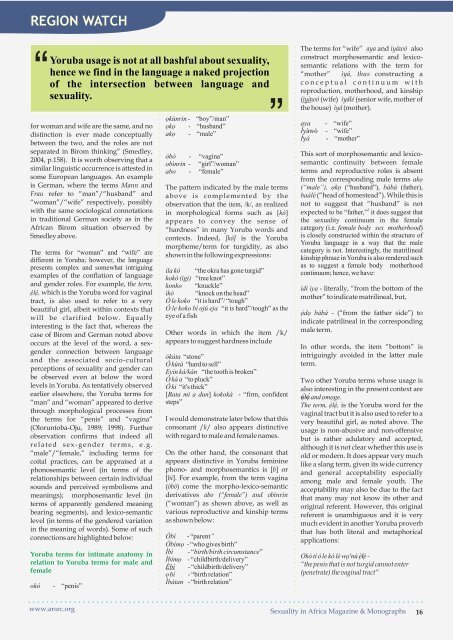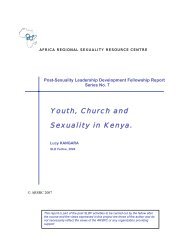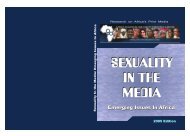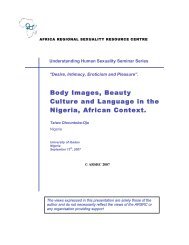Download - Africa Regional Sexuality Resource Centre
Download - Africa Regional Sexuality Resource Centre
Download - Africa Regional Sexuality Resource Centre
You also want an ePaper? Increase the reach of your titles
YUMPU automatically turns print PDFs into web optimized ePapers that Google loves.
for woman and wife are the same, and no<br />
distinction is ever made conceptually<br />
between the two, and the roles are not<br />
separated in Birom thinking” (Smedley,<br />
2004, p.158). It is worth observing that a<br />
similar linguistic occurrence is attested in<br />
some European languages. An example<br />
is German, where the terms Mann and<br />
Frau refer to “man”/“husband” and<br />
“woman”/“wife” respectively, possibly<br />
with the same sociological connotations<br />
in traditional German society as in the<br />
<strong>Africa</strong>n Birom situation observed by<br />
Smedley above.<br />
The terms for “woman” and “wife” are<br />
different in Yoruba; however, the language<br />
presents complex and somewhat intriguing<br />
examples of the conflation of language<br />
and gender roles. For example, the term,<br />
èl ò è, ò which is the Yoruba word for vaginal<br />
tract, is also used to refer to a very<br />
beautiful girl, albeit within contexts that<br />
will be clarified below. Equally<br />
interesting is the fact that, whereas the<br />
case of Birom and German noted above<br />
occurs at the level of the word, a sexgender<br />
connection between language<br />
and the associated socio-cultural<br />
perceptions of sexuality and gender can<br />
be observed even at below the word<br />
levels in Yoruba. As tentatively observed<br />
earlier elsewhere, the Yoruba terms for<br />
“man” and “woman” appeared to derive<br />
through morphological processes from<br />
the terms for “penis” and “vagina”<br />
(Oloruntoba-Oju, 1989; 1998). Further<br />
observation confirms that indeed all<br />
r e l a t e d s e x - g e n d e r t e r m s , e . g .<br />
“male”/“female,” including terms for<br />
coital practices, can be appraised at a<br />
phonosemantic level (in terms of the<br />
relationships between certain individual<br />
sounds and perceived symbolisms and<br />
meanings); morphosemantic level (in<br />
terms of apparently gendered meaning<br />
bearing segments), and lexico-semantic<br />
level (in terms of the gendered variation<br />
in the meaning of words). Some of such<br />
connections are highlighted below:<br />
Yoruba terms for intimate anatomy in<br />
relation to Yoruba terms for male and<br />
female<br />
okó<br />
Yoruba usage is not at all bashful about sexuality,<br />
hence we find in the language a naked projection<br />
of the intersection between language and<br />
sexuality.<br />
- “penis”<br />
?kùnrin - “boy”/man”<br />
?k? - “husband”<br />
ak? - “male”<br />
òbò - “vagina”<br />
obìnrin - “girl”/woman”<br />
abo - “female”<br />
The pattern indicated by the male terms<br />
above is complemented by the<br />
observation that the item, /k/, as realized<br />
in morphological forms such as [kó]<br />
appears to convey the sense of<br />
“hardness” in many Yoruba words and<br />
contexts. Indeed, [kó] is the Yoruba<br />
morpheme/term for turgidity, as also<br />
shown in the following expressions:<br />
ila kó “the okra has gone turgid”<br />
kokó (igi) “tree knot”<br />
konko “knuckle”<br />
ìkó “knock on the head”<br />
Ó le koko “it is hard”/ “tough”<br />
Ó le koko bí ojú eja “it is hard”/tough” as the<br />
eye of a fish<br />
Other words in which the item /k/<br />
appears to suggest hardness include<br />
òkúta “stone”<br />
Ó kùtà “hard to sell”<br />
Eyin ká/kán “the tooth is broken”<br />
Ó ká a “to pluck”<br />
Ó ki “it's thick”<br />
[Bata mi a dun] kokokà - “firm, confident<br />
steps”<br />
I would demonstrate later below that this<br />
consonant /k/ also appears distinctive<br />
with regard to male and female names.<br />
On the other hand, the consonant that<br />
appears distinctive in Yoruba feminine<br />
phono- and morphosemantics is [b] or<br />
[bi]. For example, from the term vagina<br />
(òbò) come the morpho-lexico-semantic<br />
derivatives abo (“female”) and obìnrin<br />
(“woman”) as shown above, as well as<br />
various reproductive and kinship terms<br />
as shown below:<br />
Òbí - “parent”<br />
Òbím? - “who gives birth”<br />
Ìbí - “birth/birth circumstance”<br />
Ìbím? - “childbirth/delivery”<br />
Èbí - “childbirth/delivery”<br />
?bí - “birth relation”<br />
Ìbátan - “birth relation”<br />
The terms for “wife” aya and ìyàwó also<br />
construct morphosemantic and lexicosemantic<br />
relations with the term for<br />
“mother” ìyá, thus constructing a<br />
c o n c e p t u a l c o n t i n u u m w i t h<br />
reproduction, motherhood, and kinship<br />
(ìyàwó (wife) ìyálé (senior wife, mother of<br />
the house) ìyá (mother).<br />
aya<br />
Ìyàwó<br />
Ìyá<br />
- “wife”<br />
- “wife”<br />
- “mother”<br />
This sort of morphosemantic and lexicosemantic<br />
continuity between female<br />
terms and reproductive roles is absent<br />
from the corresponding male terms ak?<br />
(“male”), ?k? (“husband”), bàbá (father),<br />
baálé (“head of homestead”). While this is<br />
not to suggest that “husband” is not<br />
2<br />
expected to be “father,” it does suggest that<br />
the sexuality continuum in the female<br />
category (i.e. female body sex motherhood)<br />
is closely constructed within the structure of<br />
Yoruba language in a way that the male<br />
category is not. Interestingly, the matrilineal<br />
kinship phrase in Yoruba is also rendered such<br />
as to suggest a female body motherhood<br />
continuum; hence, we have:<br />
ìdì ìya - literally, “from the bottom of the<br />
mother” to indicate matrilineal, but,<br />
òdò ? bàbá - (“from the father side”) to<br />
indicate patrilineal in the corresponding<br />
male term.<br />
In other words, the item “bottom” is<br />
intriguingly avoided in the latter male<br />
term.<br />
Two other Yoruba terms whose usage is<br />
also interesting in the present context are<br />
?Ìl? Ì and ?m?ge.<br />
The term, èlò è, ò is the Yoruba word for the<br />
vaginal tract but it is also used to refer to a<br />
very beautiful girl, as noted above. The<br />
usage is non-abusive and non-offensive<br />
but is rather adulatory and accepted,<br />
although it is not clear whether this use is<br />
old or modern. It does appear very much<br />
like a slang term, given its wide currency<br />
and general acceptability especially<br />
among male and female youth. The<br />
acceptability may also be due to the fact<br />
that many may not know its other and<br />
original referent. However, this original<br />
referent is unambiguous and it is very<br />
much evident in another Yoruba proverb<br />
that has both literal and metaphorical<br />
applications:<br />
Okó tí ò le kò lè wo' ò nú èòlèò -<br />
“the penis that is not turgid cannot enter<br />
(penetrate) the vaginal tract”<br />
16






